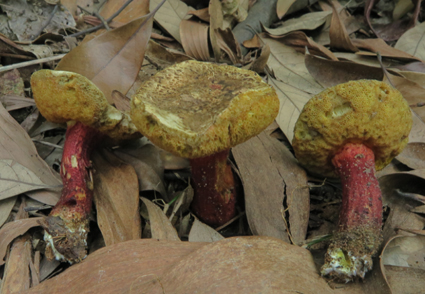Abstract
Amoenoboletus brachysporus is described as a new species from Southern China. Morphologically, it is closely related to A. granulopunctatus and A. mcrobbii, but distinguished by its relatively larger basidiomata with the pileus covered with conspicuous greyish yellow to yellowish brown patches or coarse fibrillose squamules, longer and broader stipes densely covered with dark red, appressed squamules, and obviously shorter basidiospores (7–9 × 5–6.3 μm). Phylogenetically, newly generated sequences from the new species form a distinct clade within the genus Amoenoboletus. Detailed morphological descriptions, colour photographs of the new species and comparisons with closely related taxa are presented.
References
- Arora, D. & Frank, J.L. (2014) Clarifying the butter boletes: a new genus, Butyriboletus, is established to accommodate Boletus sect. Appendiculati, and six new species are described. Mycologia 106: 464–480. https://doi.org/10.3852/13-052
- Biketova, A.Y., Gelardi, M., Smith, M.E., Simonini, G., Healy, R.A., Taneyama, Y., Vasquez, G., Kovács, Á., Nagy, L.G., Wasser, S.P., Peintner, U., Nevo, E., Bunyard, B.A. & Vizzini, A. (2022) Reappraisal of the genus Exsudoporus (Boletaceae) worldwide based on multi-gene phylogeny, morphology and biogeography, and insights on Amoenoboletus. Journal of Fungi 8: 101. https://doi.org/10.3390/jof8020101
- Binder, M. & Hibbett, D.S. (2006) Molecular systematics and biological diversification of Boletales. Mycologia 98 (6): 971–981. https://doi.org/10.3852/mycologia.98.6.971
- Chai, H., Liang, Z.Q., Xue, R., Jiang, S., Luo, S.H., Wang, Y., Wu, L.L., Tang, L.P., Chen, Y., Hong, D. & Zeng, N.K. (2019) New and noteworthy boletes from subtropical and tropical China. MycoKeys 18 (46): 55–96. https://doi.org/10.3897/mycokeys.46.31470
- Hall, B.G. (2013) Building phylogenetic trees from molecular data with MEGA. Molecular Biology & Evolution 30 (5): 1229. https://doi.org/10.1093/molbev/mst012
- Hongo, T. (1967) Notes on Japanese larger fungi (19). Journal of Japanese Botany 42: 151–160.
- Horak, H. (2011) Revision of Malaysian species of Boletales s.l. (Basidiomycota) described by E.J.H. Corner (1972, 1974). Malayan Forest Records: 51: 240.
- Hosen, M.I. & Yang, Z.L. (2021) Kaziboletus, a new boletoid genus of Boletaceae associated with Shorea robusta in Bangladesh. Mycological Progress 20: 1145–1156. https://doi.org/10.1007/s11557-021-01723-7
- Karsten, P.A. (1881) Enumeratio Boletinearum et Polyporearum Fennicarum, systemate novo dispositarum. Revue Mycologique Toulouse 3 (9): 16–19.
- Katoh, K. & Standley, D.M. (2013) Mafft multiple sequence alignment software version 7: improvements in performance and usability. Molecular Biology & Evolution 30 (4): 772–780. https://doi.org/10.1093/molbev/mst010
- Kornerup, A. & Wanscher, J.H. (1978) Methuen Handbook of Colour. 3rd edn. Eyre Methuen, London, pp. 196–265.
- Li, T., Deng, W.Q., Song, B., Zhang, M., Wang, M. & Li, T.H. (2021) Two new species of Phallus (Phallaceae) with a white indusium from China. MycoKeys 85: 109–125. https://doi.org/10.3897/mycokeys.85.75309
- Linnaeus, C.V. & Salvius, L. (1753) Species plantarum Vol. 2. Holmiae, Impensis Laurentii Salvii, Stockholm, 1176 pp.
- Loizides, M., Bellanger, J.M., Assyov, B., Moreau, P.A. & Richard, F. (2019) Present status and future of boletoid fungi (Boletaceae) on the island of Cyprus: Cryptic and threatened diversity unravelled by ten-year study. Fungal Ecology 41: 65–81. https://doi.org/10.1016/j.funeco.2019.03.008
- Mcnabb, R.F.R. (1968) The Boletaceae of New Zealand. New Zealand Journal of Botany 6 (2): 137–176.
- Murrill, W.A. (1909) The Boletaceae of North America—1. Mycologia 1 (1): 4–18.
- Nuhn, M.E., Binder, M., Taylor, A.F.S., Halling, R.E. & Hibbett, D.S. (2013) Phylogenetic overview of the Boletineae. Fungal Biology 117 (7–8): 479–511. https://doi.org/10.1016/j.funbio.2013.04.008
- Ortiz-Santana, B., Lodge, D., Baroni, T. & Both, E. (2007) Boletes from Belize and the Dominican Republic. Fungal Diversity 27 (2): 247–416.
- Ronquist, F. & Huelsenbeck, J.P. (2003) Mrbayes 3: bayesian phylogenetic inference under mixed models. Bioinformatics 19 (12): e1572. https://doi.org/10.1093/bioinformatics/btg180
- Singer, R. (1945) New Boletaceae from Florida (a preliminary communication). Mycologia 37: 797–799. https://doi.org/10.2307/3755143
- Šutara, J., Janda, V., Kříž, M., Graca, M. & Kolarik, M. (2014) Contribution to the study of genus Boletus, section Appendiculati: Boletus roseogriseus sp. nov. and neotypification of Boletus fuscoroseus Smotl. Czech Mycology 66 (1): 1–37. https://doi.org/10.33585/cmy.66101
- Vilgalys, R. & Hester, M. (1990) Rapid genetic identification and mapping of enzymatically amplified ribosomal DNA from several Cryptococcus species. Journal of Bacteriology 172: 4238–4246. https://doi.org/10.1128/jb.172.8.4238-4246.1990
- White, T.J., Bruns, T.D., Lee, S. & Taylor, J. (1990) Amplification and direct sequencing of fungal ribosomal RNA genes for phylogenetics. In: Innis, M.A., Gelfand, D., Sninsky, J. & White, T. (Eds.) PCR Protocols: a guide to methods and applications. Academic Press, San Diego, 315–322 pp. https://doi.org/10.1016/B978-0-12-372180-8.50042-1
- Wu, G., Feng, B., Xu, J.P., Zhu, X.T., Li, Y.C., Zeng, N.K., Hosen, M.I. & Yang, Z.L. (2014) Molecular phylogenetic analyses redefine seven major clades and reveal 22 new generic clades in the fungal family Boletaceae. Fungal Diversity 69 (1): 93–115. https://doi.org/10.1007/s13225-014-0283-8
- Wu, G., Li, M.X., Horak, E. & Yang, Z.L. (2022) Phylogenetic analysis reveals the new genus Amoenoboletus from Asia and New Zealand. Mycologia 114 (1): 144–156. https://doi.org/10.1080/00275514.2021.1971450
- Wu, G., Zhao, K., Li, Y.C., Zeng, N.K., Feng, B., Halling, R.E. & Yang, Z.L. (2016) Four new genera of the fungal family Boletaceae. Fungal Diversity 81: 1–24. https://doi.org/10.1007/s13225-015-0322-0
- Zhao, K., Wu, G., Halling, R.E. & Yang, Z.L. (2015) Three new combinations of Butyriboletus (Boletaceae). Phytotaxa 234 (1): 51–62. https://doi.org/10.11646/phytotaxa.234.1.3
- Zhao, K., Wu, G. & Yang, Z.L. (2014) A new genus, Rubroboletus, to accommodate Boletus sinicus and its allies. Phytotaxa 188 (2): 61–77. https://doi.org/10.11646/phytotaxa.188.2.1


